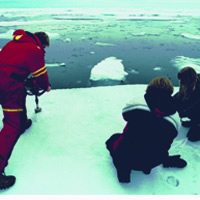History of the International Polar Year

Photo courtesy Carl Benson

Image courtesy of NOAA
Point Barrow Expedition, 1881-1883

© Bjørn Anders Nymoen
1882-1883 First International Polar Year
The Austrian explorer and naval officer Lt. Karl Weyprecht, a scientist and co-commander of the Austro-Hungarian Polar Expedition of 1872-74, inspired the International Polar Year. Weyprecht believed that understanding Earth's geophysical phenomena would require a coordinated international effort and this became the key concept of the first IPY. Twelve countries participated, and 15 polar expeditions were completed, advancing science and geographical exploration. The first IPY set a precedent for international science cooperation.
1932-1933 IPY-2
The International Meteorological Organization proposed and promoted the second IPY to investigate the global implications of the newly discovered jet stream. Forty nations participated, heralding advances in meteorology, magnetism, atmospheric science, and the mapping of ionospheric phenomena that advanced radio science and technology.
Forty permanent observation stations were established in the Arctic during IPY-2. In Antarctica, the United States' contribution was the second Byrd Antarctic Expedition that established a winter-long meteorological station approximately 125 miles south of Little America Station on the Ross Ice Shelf.
1957-1958 IPY-3 and the International Geophysical Year
The International Geophysical Year celebrated the previous International Polar Years, and was the brainchild of eminent physicists at the time, including the University of Alaska's Sydney Chapman. Chapman, James Van Allen, and Lloyd Berkner hoped to redirect the technology and scientific momentum developed during World War II towards advances in research, particularly in the upper atmosphere.
Many notions about Earth's geophysics were revised as a result of IPY-3 and the International Geophysical Year. The theory of continental drift was confirmed, the Van Allen radiation belt was discovered by a U.S. satellite, the size of Antarctica's ice mass was estimated, and much more.
The Geophysical Institute at the University of Alaska Fairbanks was elevated to international prominence during IPY-3 and IGY. Today, the institute is renowned for studies in atmospheric science; snow, ice and permafrost; earthquakes and volcanoes; and space physics and aeronomy.
2007-2009 IPY-4
The fourth International Polar Year will focus on Earth's atmosphere, ice, land, oceans, people and space. More than 300 institutions from 38 countries are participating. Of the 208 clusters of projects endorsed by the IPY International Programme Office, 28 percent have participation from the University of Alaska.
The University of Alaska is our nation's only Arctic university. During the International Polar Year, UA will examine its unique location with the North by 2020 project, bringing a network of scholars, scientists, and educators together to inspect challenges and opportunities in the Arctic.
The IPY Young Researchers' Network, a group of graduate students, postdoctoral fellows and early-career researchers, was established in 2006 to promote the International Polar Year through informal lectures, community-based monitoring projects, and activities to engage K-12 educators and their students.


